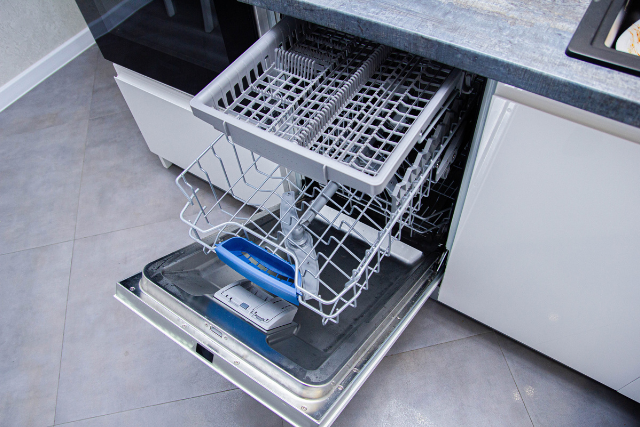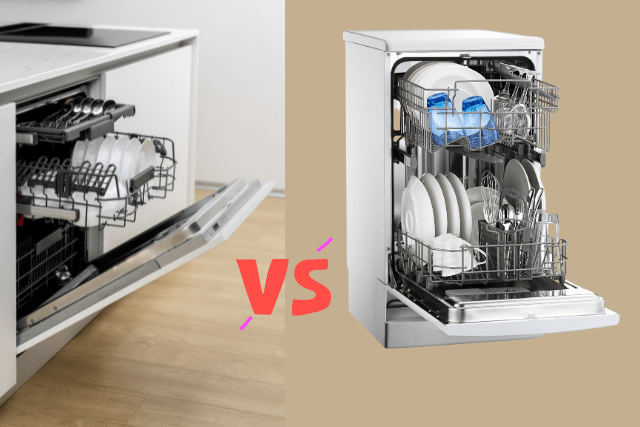Choosing the right dishwasher for your kitchen is a decision that can impact both functionality and aesthetics.
With options ranging from built-in to freestanding dishwashers, it’s important to research to ensure you make the best choice for your budget and lifestyle.
In this comprehensive guide, we’ll explore the key differences between built-in and freestanding dishwashers, the pros and cons of each, and important factors to consider when making your decision.
What is a Built-in Dishwasher?
A built-in dishwasher, as the name suggests, is designed to be permanently fixed into place in your kitchen. These dishwashers are typically installed beneath countertops or between cabinets, seamlessly integrating with your kitchen design. There are two types of built-in dishwashers: semi-integrated and fully integrated.
Semi-integrated Dishwashers expose a portion of their door panel, usually protruding slightly from the adjacent cabinets. While they can be mounted beside cabinets or underneath a countertop, they do not sit completely flush.
Fully Integrated Dishwashers are permanently built into your kitchen fixtures, with their doors flush with the doors of adjacent cabinets. This creates a seamless and cohesive look throughout your kitchen.
Built-in dishwashers offer a sleek, polished appearance that complements a minimalist or contemporary kitchen design. They are typically hardwired to your home’s electrical system and require professional installation.

What is a Freestanding Dishwasher?
On the other hand, a freestanding dishwasher is not fixed to any specific location in your kitchen. These dishwashers can be installed anywhere with access to a water inlet line and a wall outlet. There are two types of freestanding dishwashers: full-size and countertop.
Full-size freestanding dishwashers are similar in size and operation to built-in dishwashers. However, they offer the flexibility of being movable, allowing you to relocate them if needed.
Countertop Dishwashers: Countertop dishwashers are smaller and sit on your kitchen counter. They are a compact and space-saving option, ideal for kitchens with limited space or smaller households.
Freestanding dishwashers are typically controlled using a button or touch control panel on the front of the door. They offer versatility and the ability to be easily moved or replaced if you decide to change your kitchen layout or move homes.

Built-in vs Freestanding Dishwashers: A Comparison
Now that we have a basic understanding of built-in and freestanding dishwashers let’s compare them across several key factors to help you make an informed decision.
Design and Aesthetics
Built-in dishwashers are designed to seamlessly blend with your kitchen cabinets, offering a cohesive and integrated look. With fully integrated models, the dishwasher door is flush with adjacent cabinet doors, creating a sleek and uniform appearance.
On the other hand, Freestanding dishwashers come in various finishes, including stainless steel and anthracite grey, offering a more relaxed and versatile style. They can be matched to freestanding appliances, such as fridges and stoves, without brand consistency.
Installation and Mobility
Built-in dishwashers require professional installation as they are fixed into place and often hardwired to your home’s electrical system. Once installed, they become a permanent part of your kitchen layout. This ensures stability and eliminates the risk of the water inlet line or power cord becoming undone.
Freestanding dishwashers offer greater mobility and flexibility. They can be easily moved or replaced, making them a convenient option if you change your kitchen layout or move homes. However, their mobility also poses a higher risk of the water and drain lines and the power cord becoming undone.
Space and Capacity
Built-in dishwashers are typically 24 inches wide and accommodate up to 14 place settings per cycle. They are ideal for larger households or those who frequently entertain guests. However, they may not be suitable for kitchens with limited space.
Freestanding dishwashers come in both full-size and countertop options. Full-size freestanding dishwashers are usually 18 inches wide and can wash eight place settings simultaneously. They offer a balance between capacity and space-saving. Countertop dishwashers are even smaller, perfect for compact kitchens or smaller households.
Features and Functionality
Built-in dishwashers often offer a wider range of features compared to freestanding models. These features can include multiple spray arms, specialized wash programs, and advanced functions such as automatic load recognition. Built-in dishwashers are designed to provide optimal performance and efficiency.
Freestanding dishwashers may have more basic features but offer essential functions such as different time settings, eco modes, and half-load washes. While they may not have the same advanced features as built-in dishwashers, they can still effectively clean your dishes.
Noise Level
Built-in dishwashers, especially those with a front door, tend to be quieter due to their ability to be concealed behind cabinetry. The cabinet acts as a sound barrier, reducing the noise generated during operation. This is particularly beneficial if you prefer a quieter kitchen environment or have an open-concept layout.
Freestanding dishwashers, however, do not have the same soundproofing capabilities as they do not fit behind cabinetry. The noise produced during operation is not significantly dampened, making them more audible. If the noise level is a concern, consider running the dishwasher at nighttime or opting for an under-the-counter built-in dishwasher.
Cost
Built-in dishwashers are generally more expensive than freestanding models. The cost includes not only the dishwasher itself but also the installation, which often requires professional assistance. However, a built-in dishwasher can increase your home’s value and enhance your kitchen’s aesthetic appeal.
Freestanding dishwashers are more affordable and do not require specialized installation. They offer a cost-effective option for those on a budget or who prefer the flexibility of moving or replacing their dishwasher easily.
Energy Efficiency
Both built-in and freestanding dishwashers can be energy efficient, depending on the model and features. Look for energy labels and consider factors such as water usage per cycle and eco programs that minimize water and energy consumption. Investing in a dishwasher with energy-saving features can help you reduce your utility bills and minimize your environmental impact.
Also Read: Best Dishwasher in India
Conclusion
Choosing between a built-in and freestanding dishwasher ultimately depends on your preferences, kitchen layout, and budget. Built-in dishwashers offer a seamless and integrated look, stability, and often more advanced features, but they come at a higher cost and require professional installation. Freestanding dishwashers provide mobility, affordability, and flexibility, making them suitable for those who value convenience and easy relocation.
Consider the available space in your kitchen, your desired aesthetic, and the important features when deciding. With careful consideration, you can find the perfect dishwasher that meets your needs and enhances your kitchen experience.
Frequently Asked Questions
What is the difference between a built-in dishwasher and a freestanding dishwasher?
The main difference between a built-in dishwasher and a freestanding dishwasher is where they are installed. A built-in dishwasher is designed to be installed under a kitchen countertop and will have a cabinet door attached to the front to match your cabinetry. On the other hand, a freestanding dishwasher can be placed anywhere in your kitchen and does not require any installation.
What is an integrated dishwasher?
An integrated dishwasher is a type of dishwasher that is designed to be built into your cabinetry. It is a type of built-in dishwasher, but it offers a more seamless look as the control panel is located on the top of the door and is not visible when closed.
What is a semi-integrated dishwasher?
A semi-integrated dishwasher is another type of built-in dishwasher. It has a visible control panel on the front of the door, while the rest of the dishwasher is built into the cabinet.
Can I install a dishwasher myself?
Installing a dishwasher can be a complicated process that typically requires a plumber. It is recommended to have a professional install a built-in dishwasher, as it will require connections to your cabinet, water line, and electrical systems. They can ensure the dishwasher is properly installed and all connections are secure.
What are the benefits of a built-in dishwasher?
Built-in dishwashers are typically quieter and more energy efficient than freestanding models. They also offer a cleaner and more streamlined look as they can be built into your cabinetry.
What are the benefits of a freestanding dishwasher?
Freestanding dishwashers are easier to install and can be moved more easily than built-in models. They also offer more flexibility regarding placement, as they do not require a cabinet to be built around them.
What size dishwasher should I choose?
The size of the dishwasher you choose will depend on the size of your kitchen and how many place settings you typically need to clean at once. Standard dishwashers are typically 24 inches wide and can accommodate 12-place settings. Smaller countertops and portable dishwashers are also available for smaller kitchens or households.
What type of dishwasher is best for my kitchen cabinets?
If you want your dishwasher to blend seamlessly with your kitchen cabinetry, a fully integrated dishwasher is the best choice. A semi-integrated dishwasher may be a better option if you prefer a visible control panel and don’t mind a small gap between your cabinet and the dishwasher.
Can I install a dishwasher in any kitchen?
You can install any dishwasher in most kitchens if the plumbing and electrical connections are in place. Built-in dishwashers require some customization, so you may need to hire a plumber or a contractor to install them.
Can I choose a built-in dishwasher if I have existing kitchen cabinets?
Yes, you can choose a built-in dishwasher in most kitchen designs. However, you may need some cabinetry work to accommodate the machine’s size and plumbing connections. Sometimes, you may need to replace some of your kitchen cabinets.
Are freestanding dishwashers easier to install?
Yes, freestanding dishwashers are generally easier to install because they don’t require customized cabinetry or plumbing work. However, you will still need to connect the unit to a water line and ensure it has a proper drain.







